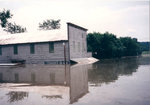




At 2:10 a.m. on July 25, 1993, Sabreliner employee Craig Buchheit awoke to an urgent phone call. After days of flood warnings, statements, evacuations and preparations, the Mississippi River had finally become too much for the 50-foot Bois Brule Levee to hold back. Monday, July 25, marks the 29th anniversary of the catastrophic breach that resulted in at least 26,000 acres of flooded farmland, an estimated $13 million loss in sorghum, wheat, soybeans, and corn, and at least 90 flooded homes and businesses, including the Sabreliner Corporation at Perryville Regional Airport and Gilster Mary-Lee’s popcorn and cereal plant in McBride, Mo.
“I was the closest employee, so when I managed to get up and get dressed, I jumped in my car and headed to the airport,” Buchheit remembers. “On my way, I was stopped in McBride on the levee by a state highway patrolman. I remember him telling me that the levee broke, that there was no one allowed to go in. I remember vaguely that I looked at him and I said, ‘Well, sir, I’m going in, but if you wanna come you can.’ He told me to go, and I could not believe my eyes. He was right behind me.”
Buchheit, who served as an aircraft lead mechanic at the time, shared that his sense of urgency was due to the threat of floodwaters ruining a $7 million airplane that had just been painted. If he was able to get the aircraft untaped and ready for flight, Buchheit had every intention of doing so.
The rise in river levels were the result of higher-than-usual wet falls in the previous year, according to a report from the National Weather Service. Some areas had received more than 4 feet of rain during the period leading up to the flood, which resulted in “above normal soil moisture and reservoir levels in the Missouri and Upper Mississippi River basins”. A July 27, 1993 article in The New York Times noted that rocky river bottoms in the Perry County and Cape Girardeau regions contributed to the river’s restricted movement, in contrast with the sandy and muddier river bottoms found below Cairo, Ill. It was a recipe for disaster, and disaster struck quickly.
As the 300-400 foot breach in the levee began to spread, sending flood waters gushing through the gap into what has long been referred to as The Bottoms, Buchheit and the state highway patrolman made their way to the airport and Sabreliner Corporation.
“When we got to the airport, there was no way to get in the buildings,” Buchheit said. “I knew everything would be locked up, but I remembered one window in the woodshop that was always kept unlatched. I was able to raise the window up to crawl in, while the state patrolman crawled in behind me. Of course it was nighttime, so I had to take a flashlight and work my way through the buildings. When we finally made it [to the paint shop], we both commenced to untaping and unpapering the Sabreliner jet that was sitting there.
“He was just like another employee, and I was so impressed at how fast he worked. We knew we didn’t have long before water was gonna start coming in. We both worked for about an hour before other people started showing up. We got it untaped, pulled it out, and the pilot came to pick it up. It was a pretty scary situation. I still don’t know who the state patrolman was that helped me, but that man was just as hard-working as I was and I was so impressed that he volunteered his time.”
Within hours, the break in the levee had widened to 1,200 feet, according to a report by the State Emergency Management Agency. Buchheit and the other employees were forced to evacuate until it was safe to return.